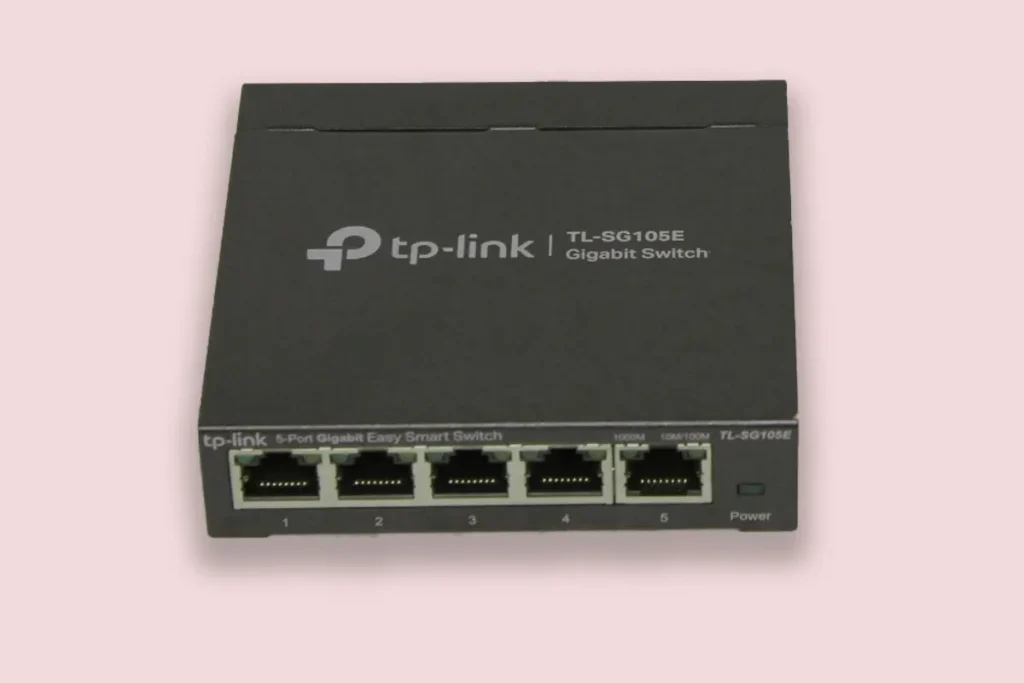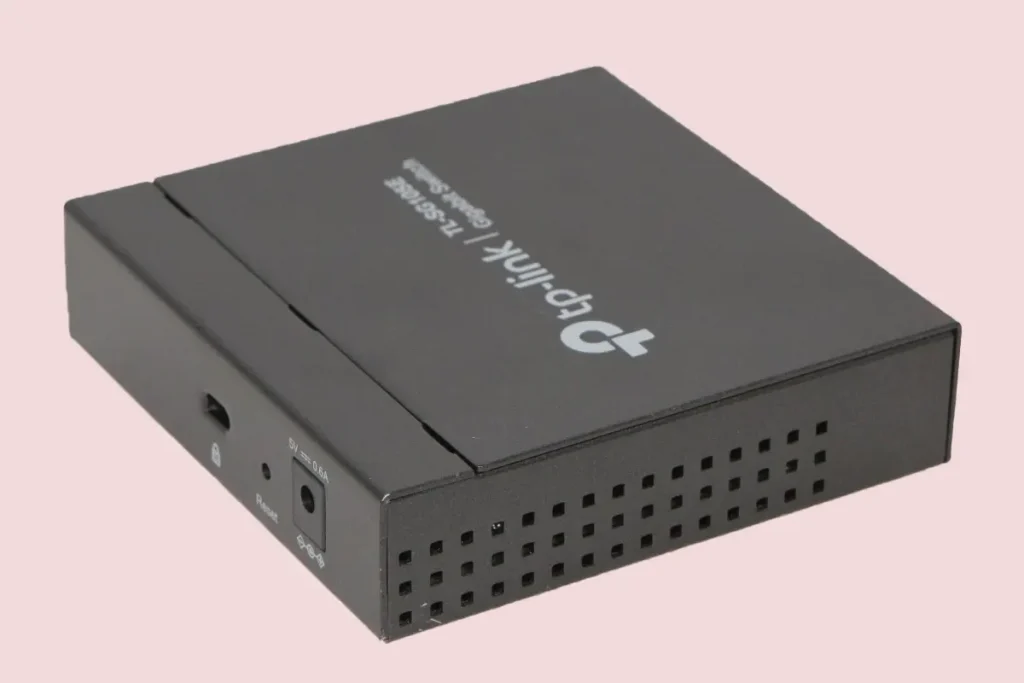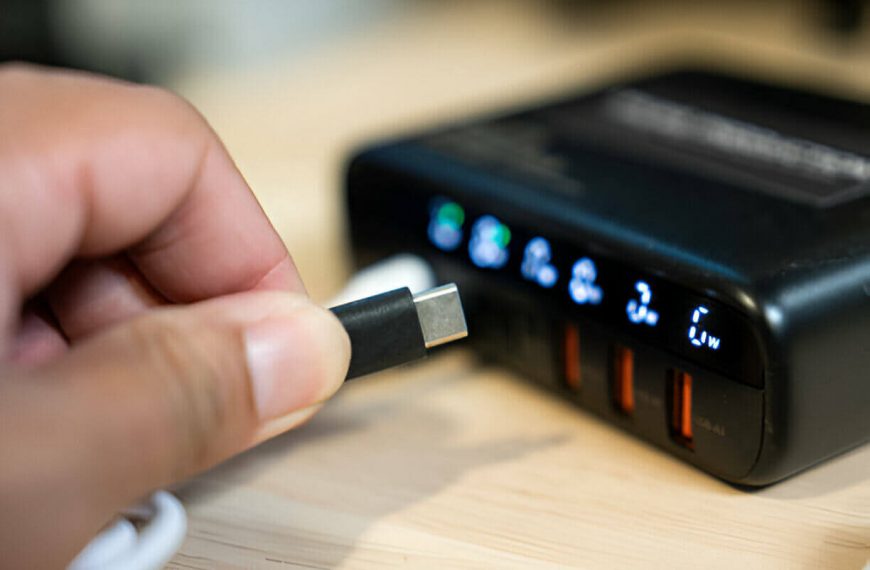This little black box isn’t some flashy gadget craving attention. It’s a 5-port gigabit Ethernet switch that gets out of your way and just works. Plug it in, connect your devices, and boom – they start talking at full gigabit speed. No configuration drama. No nonsense.
But this isn’t your basic switch either. The TL-SG105E sits somewhere between unmanaged and smart. It’s technically an “Easy Smart” switch, which means you get basic network controls without needing a networking degree.
Out of the box

Unboxing the TL-SG105E is about as exciting as opening a box of screws – and I mean that lovingly. What you get: the switch, a power adapter, some documentation, and a few sticky rubber feet.
It’s the kind of no-frills packaging that screams, “We’re not here to impress you with foam inserts.”
Build quality that deserves a fist bump
Let’s talk about the housing. This thing feels like it could survive a drop off your desk and still work. All-metal casing, fanless, compact. The finish? Matte black with a slight industrial edge. Five shielded ports line the front, each with its own LED indicator. No rattles. No plasticky nonsense.
It’s palm-sized but weighty enough to stay put. Whether it lives behind your monitor or next to your router, it won’t look out of place.
Setup: You plug, it plays. Simple.
The beauty of this switch is in its simplicity. You don’t need to mess with IP addresses to get going. Plug it in, connect your Ethernet cables, and you’re live.
Now if you do want to access its configuration options, you’ll need to install TP-Link’s Windows-only utility. That’s a bit of a letdown for Mac and Linux users. Also, make sure your computer is on the same subnet or the utility won’t find the device. Been there. Not fun.
Once inside, you can assign VLANs, prioritize traffic, monitor activity, and a few other handy tricks. It’s not a full-blown managed switch, but for home users and small offices? More than enough.
VLANs: Segmentation without headaches
One standout feature is VLAN support. You can separate traffic between devices, which is great if you’re trying to keep your IoT gear away from your NAS or isolate security cams.
You get port-based VLAN and 802.1Q tagging. If those words sound scary, don’t panic. It means you can group devices logically, even if they’re plugged into the same switch. Setup takes a few clicks in the config tool. Just label the ports and go.
QoS: Because not all traffic is created equal
If your video calls keep glitching every time someone downloads a game, this part is for you. The TL-SG105E allows you to prioritize traffic using QoS (Quality of Service). You can set high priority to voice or streaming data, so your Zoom doesn’t freeze when your roommate updates Call of Duty.
It supports both port-based and tag-based QoS. Translation? You get to decide who gets the fast lane.
Multicast & IGMP Snooping: More efficient streaming
This switch also helps with streaming content over your network, especially if you’re using IPTV or multiple devices to access the same stream. IGMP Snooping basically helps reduce unnecessary traffic. Think of it as traffic control for your packets.
If you’re running a Plex server, IP cams, or any kind of multicast setup, you’ll notice smoother performance. It’s one of those features that you don’t think you need until you do.
Network tools for nerds
You also get port mirroring, loop prevention, and cable diagnostics. Translation? You can monitor traffic, stop network loops, and troubleshoot bad cables – all from that basic interface.

Performance: Rock solid
I threw all kinds of traffic at it: file transfers, game downloads, streaming, security cams, and remote backups. Not a hiccup. It handled simultaneous tasks without breaking a sweat.
Ports negotiate at full gigabit. There’s no internal bottleneck. And yes, jumbo frames are supported for those big file transfers. Just make sure your devices support them too.
Power use: Efficient without trying too hard
It has green Ethernet tech baked in. That means it lowers power to idle ports and adjusts based on cable length. You don’t need to do anything. It just sips power instead of chugging it.
The thing runs cool. No fans. No noise. Just quiet performance.
Security & firmware talk: Time to get real
Okay, here’s the catch. This switch has had its share of firmware gripes. Past versions had hardcoded passwords and other poor choices. TP-Link has cleaned some of that up, but updates are infrequent.
If you’re serious about security, keep remote management off unless you need it. And use strong local network security. For most home users, it’s fine. For paranoid IT pros? Maybe look elsewhere.
Pros and Cons
Pros
- Rock-solid metal build
- Fanless design – Silent operation even under load.
- Simple plug-and-play
- Energy-efficient – Reduces power to idle ports automatically.
Cons
- Windows-only config utility – Mac and Linux users, you’re out of luck for setup.
- Limited firmware updates
Real-world use cases
- Home offices juggling work Zooms, smart TVs, and NAS backups.
- Small businesses wanting to segment guest networks from staff.
- Gamers wanting to keep latency low while everyone else hogs the Wi-Fi.
This thing handles them all without needing babysitting.
Final verdict:
If your network has outgrown your basic switch but you’re not quite ready for full-blown managed gear, this is the one.
It’s not a showstopper. It’s not trying to be. But sometimes, the quiet performers are the ones you remember most.












